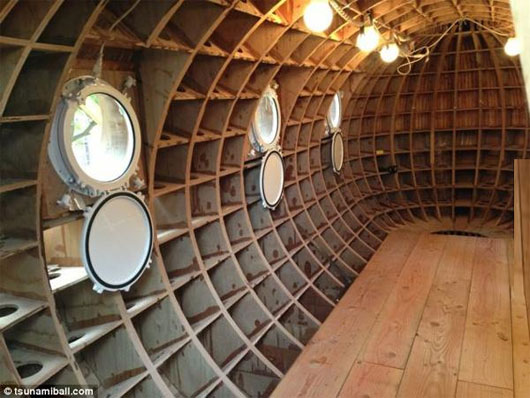Floating houses avoid tsunamis
After the tsunami disaster in March 2011 in Japan, designer Chris Robinson decided to create an architecture that could ensure he and his family could survive if the same tsunami happened in the countryside. His flavor is Palo Alto, California (USA).

Photo: Tsunamiball.com
After several years of design and construction, architecture called Chris Robinson's Tsunamiball is about to be completed. Although he had no previous experience with boat building, Robinson managed to make Tsunamiball, just like a boat shaped like an egg. Through conversations with friends about floods, tsunamis and ideas of how to avoid family disasters, Robinson eventually designed this floating device.
The architecture is actually 6 x 3 x 2.5m in size. The main material is plywood, 6.4 cm thick body, covered with a wear-resistant polyester cover and reinforced with epoxy to create a durable outer layer like kevlar material. At least it was not damaged when it collided with the floating debris created by the disaster. This architecture also has a window to observe. When formed, the whole body will consist of 60 layers of wood to ensure durability. Initially the screws and glue will be used to mount the wood layers together. After finishing, the screws will be removed.
Robinson told Gizmag magazine that the basic part had been completed, followed by installing Tsunamiball with solar panels, an electric generator, designing toilets, kitchen areas, food storage. and of course rests.
Information from Tsumaniball.com indicates that Robinson expects to complete everything by the end of 2014 and will fully check his work.
- Floating houses on the sea can resist strong storms of level 4
- Surprise with the way people of the previous century predicted the houses of our time
- Nigeria built a floating school
- The eggs-shaped eco-houses are extremely toxic
- Floating ball to save people in tsunami
- Floating houses for flood areas
- Strange houses in the world
- 10 beautiful floating buildings in the world
- Floating houses help cope with climate change
- The project of building a dragon island contains 10,000 floating houses
- Vietnam has a scenario to deal with tsunamis
- This is the best way to deploy solar power if there is not much land available
 Norway built the world's tallest wooden tower
Norway built the world's tallest wooden tower Kremlin
Kremlin Ashurbanipal: The oldest royal library in the world
Ashurbanipal: The oldest royal library in the world Decoding the thousand-year construction of Qin Shihuang shocked the world
Decoding the thousand-year construction of Qin Shihuang shocked the world